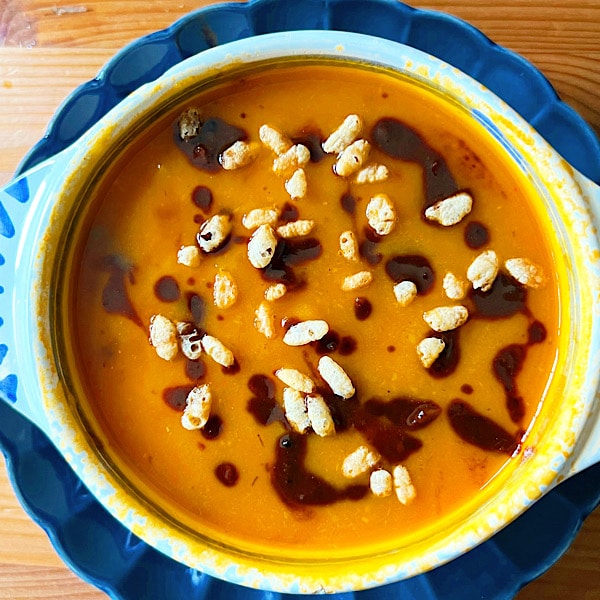I’m taking the liberty of calling these ‘Irish Scones’ after they got the ‘Just like my Granny’s!’ seal of approval from my Irish friend Janet. (I also think of them as Irish Janet’s Scones since she often refers to me as ‘American Mary….’) And indeed, what I was after was the taste and texture of the scones I’ve enjoyed on trips to Ireland: light and layered, dry and crumbly (but not overly so), not too sweet or too buttery or too laden with raisins (or other dried fruit) so that the flavor is distinct from the butter and jam that’s spread (thickly) on top.
The secret to achieving these things is 1) a whopping lot of leavening (baking powder and soda), and 2) a dry-ish dough that calls for only the amount of buttermilk or sour milk you need to hold it together.
The recipe makes 12 large scones (or 16 smaller ones), which may seem like too much unless you do what I do—and what professional bakers do—and freeze them raw to be baked off later.
3 cups (450 g.) all-purpose flour
¼ cup (60 g.) sugar
2 Tbs. baking powder
¾ tsp. baking soda
1/2 tsp. salt
7 Tbs. (3 ½ oz./100 g.) cold butter, cut into small pieces
1¼ cups (300 ml.) buttermilk or sour milk*, preferably whole
3 /4 to 1 cup (100 to 150 g.) raisins or other dried fruit
1 egg, beaten, optional, for brushing the scone tops
PREHEAT the oven to 425˚F/210˚C. Line a baking sheet with parchment paper, or coat with cooking spray.
WHISK together the flour, sugar, baking powder, baking soda, and salt in a large bowl.
RUB the butter into the flour with your fingertips until mostly combined—it’s ok if a few pea-sized lumps remain.
STIR in 1 cup (230 ml.) of the buttermilk or sour milk with a spatula or wooden spoon until a thick dough starts to come together. Add just enough of the remaining liquid to have a soft but not sticky dough that picks up all the flour in the bowl. Stir in the raisins or dried fruit
TURN OUT the scone dough onto a well-floured work surface, and pat flat. Fold the dough in half, pat flat again, then repeat this folding and patting process 3 more times (4 total). This helps distribute the raisins without overworking the dough.
PAT or roll the dough out to a disk or square that is 1 inch (3 cm.) thick. Cut the dough into 12 large or 16 small scones using a round cutter—or you can cut the dough into triangles or small squares. Place the scones on the prepared baking sheet, and brush with the egg, if desired. Bake 10 to 12 minutes for small scones, 12 to 15 minutes for large scones, or until they are golden brown on both top and bottom. Serve hot from the oven or cold. The scones will keep well up to 1 day. After that, they can be split and toasted if they get too hard.
TO FREEZE SCONES: Place cut scones on a parchment-lined baking sheet, then place the baking sheet in the freezer until the scones are frozen solid. Transfer the frozen scones to a resealable plastic bag or container, and store 1 to 3 months in the freezer. To bake off the scones, simply remove them from the freezer and place them on the baking sheet just before preheating the oven to 400˚F/200˚C (not 425/210), then add about 5 to 10 minutes to the baking time.
*To sour fresh milk, stir 1 Tbs. vinegar or lemon juice into 1 (or 1 ¼ as the case here) cup(s) fresh milk. Let stand 5 minutes until the milk curdles or clabbers (prettier word), then use. You can also just thin plain yogurt with milk as a substitute for buttermilk or sour milk.



Finally got around to making scones for the first time ever at the ripe old age of 45. These really did take me right back to my Granny J’s kitchen! Thank you so much Mary!
I made these for the first time tonight as the house was wanting something sweet but not too sweet. Very good. I baked them 13.5 minutes as they were very golden on top and brown on the bottom. They are very good. We put some butter and homemade apricot jam on them. Sooooo good! I thought they were a little soft in the middle, not raw but soft. It may have something to do with being above a mile high in ABQ. Any suggestions? Do you have a recipe for poppyseed lemon scones? Thank you for your recipe. 😋❤️🙏
So glad you like this recipe! I return to it often. I’m wondering if your oven temperature might be off (many ovens are…in fact I keep a separate thermometer in mine just in case) if the scones were brown on top and bottom but soft in the middle. For lemon poppyseed scones, you could add 1 Tbs. grated lemon zest and ¼ cup poppyseeds to this recipe. Thanks again for your comment!
These are just out of the oven and wow! I love them! Thanks!
Late reply Valerie – so glad the recipe worked for you!
Tried these for the first time. Added dried cherries for the fruit. They turned out soo good and had raised the highest I’ve ever had.
My whole family said to keep this recipe. Guess I’m glad the milk spoiled or I wouldn’t of looked for new ways to use it up.
Oh, I’m so glad the recipe worked for you! It’s a good recipe even if you don’t have spoiled milk…and my Irish friend has given it to her family so they can up their game.
I was looking for ideas for using up sour milk (I had already made pancakes with some it) – and was led to your website. Thank you for encouraging people not to waste food! This is my mantra!
I chose to make the scones, but didn’t want raisins, so replaced half the butter with grated extra-old cheddar cheese. Should have used a bit more cheese, but the scones were yummy even though there was only a hint of cheesiness. I also switched one cup of the flour to whole wheat.
I know: first time using a new recipe and I still don’t follow the recipe! But thank you for the idea and the non-sweet scones to enjoy with my homemade (from leftovers!) turkey soup.
Oh, I’m so glad you tried the recipe – and I’m so glad you did so with sour milk. I love all your adjustments – they’re done with intelligence (i.e., you didn’t try to use all whole-wheat flour!). The more cheese thing…I am always amazed at how much cheese it takes to make baked goods cheesy. It’s hard to overdo it. All the best and happy baking!
Made twelve scones with sour milk which were delicious. I actually forgot to put the fruit in but it didn’t matter with butter and jam. Thanks.
Oh, I’m so glad it worked for you. I think scones are one of the best uses for sour milk.